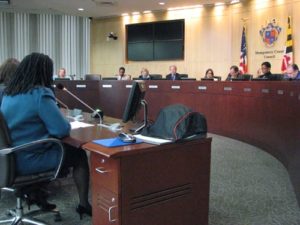Last week, we encouraged Montgomery County Council to support the FY13 arts and humanities budget. Read my testimony below!

Good afternoon. I am Suzan Jenkins, CEO of the Arts and Humanities Council of Montgomery County and a twenty-three year resident of Rockville. I begin my testimony today by simply saying Thank You!
Thank You! for your past support for funding the arts and humanities in previous Montgomery County Operating Budgets.
Thanks for considering support of the FY13 budget recommendation which includes flat funding for arts and humanities grants.
Given the slow economic recovery in the County and the nation, we appreciate that all areas of the budget are under close scrutiny. We understand the tough choices you make every budget season and the uncertainty of the County’s FY13 appropriations in the wake of State’s failure to pass a budget. So, first of all let us say Thank you!
Thank you from the 31 Large Organizations that received over $2.6M in operating support grants.
Thank you from the 20 Mid-Size Organizations that received over $252,000 in grants to support their programs and projects.
Thank you from the 9 Small Organizations that received over $27,000 in grants to support their programs.
Thank you from the 9 individual artists and scholars that received over $31,000 in grants to support their work.
Thank you from the artists, arts groups and scholars that received nearly $16,000 in grants to provide dynamic education programs to 900 children and adults with disabilities, senior citizens, and children and teens at high-risk for academic failure and gang violence.
Thank you from the teaching artists who received over $31,000 in grants to lead arts integration residencies for students in 12 low-income schools in Montgomery County. These residencies use performing, visual and literary arts to help academically-challenged students explore and learn core curriculum subjects.
The arts and humanities are so much more than luxury activities for wealthy elite. They are key ingredient in a healthy and robust community.
Here are six reasons why:
#1 Creativity Fills in Social Service Gaps for the County’s Neediest Citizens: Arts and humanities programs address the needs of adults with disabilities, senior citizens, children and youth who are risk for academic failure and gang violence, incarcerated youth. Our reach extends to Family Services, the Regional Institute for Children and Adolescents, The Children’s Inn at NIH, the Boys & Girls Clubs, and CHI Centers for adults with disabilities, and senior communities.
#2 Creativity Fosters Tomorrow’s Innovative Workforce: Today’s CEOs value creativity over integrity and global thinking. An arts-infused education not only enhances academic achievement, but also helps children develop critical thinking skills, innovation, self-discipline and teamwork—all key ingredients in future workplace success. Our Mid size and large organizations serve over 872,000 school children every year.
#3 JOBS! Over 3,448 jobs in Montgomery County that can never be outsourced. The arts and humanities sector puts people to work. Not just artists and scholars, but electricians, marketers, technicians, teachers, designers, carpenters, parking staff, caterers and workers in a wide variety of other trades and professions. Like other industries, the staff we employ pay mortgages, local taxes, and purchase goods and services right here in Montgomery County.
#4 We innovate. We leverage significant private and public investments to deepen our impact. The Nonprofit Energy Alliance, a partnership with Nonprofit Montgomery, the Nonprofit Roundtable, and the Department of Environmental Protection saves its 50 participating organizations annually about $366,000 in fixed utility expenses, allowing organizations to reduce expenditures on electricity and free up resources for their core missions while significantly reducing their carbon footprint. The impact is equivalent to taking 1700 cars off the roads or powering 700 homes over a one-year period.
#5 The creative sector produces a highly-skilled and desirable workforce.
Gary Skulnik, President of Clean Currents, a retail electricity supplier and partner in the NonProfit Energy Alliance, says that “Training in the arts is the best way to develop young people to be competitive in the work force. Exposing people to the arts is an integral part of a job training and economic development plan.” Why? Because business people like Gary Skulnik are looking for employees who think broadly, who excel in communications, and who have a passion for positive change and innovation. That’s what children learn from the arts.
#6 Return on Investment. Right now, today, the arts and humanities industry is pumping over $57 million annually back into our economy through direct expenditures on everything from paper clips and cans of paint to employee compensation, to contracts for services and supplies uniquely spent by this sector. For every dollar the County gives AHCMC in grants, arts and humanities organizations match it with an additional $15.60 in city/state/federal/ donated and contributed income.
There’s no doubt about it, Montgomery County’s arts and cultural resources are an economic asset. The creative sector provides jobs, attracts investments, and stimulates local economies through tourism, consumer purchases, and tax revenue. Perhaps even more significantly, the creative sector prepares workers to participate in the contemporary labor force, create communities with high appeal to residents, businesses, and tourists, and contribute to the economic success of other sectors.
I urge you today to continue to recognize the arts and humanities in Montgomery County as your partner in economic recovery and thank you for your continued support.
Suzan Jenkins, CEO
Arts and Humanities Council of Montgomery County
Ask your Councilmember to support the FY13 arts and humanities budget! Click here to visit our Take Action page for resources and more information.
